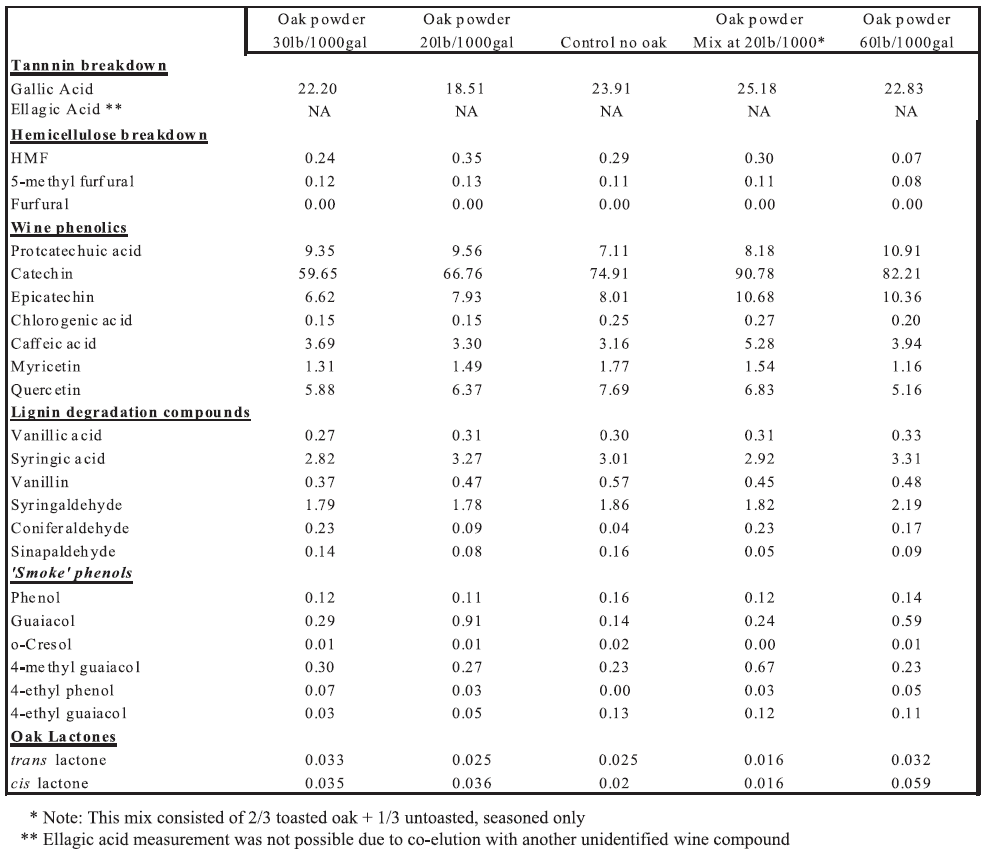Beaulieu Vineyard
OBJECTIVE
The objective is two-fold: 1) To test the effect of oak powder addition during the fermentation of Cabernet Sauvignon grapes, and 2) to test the effects of different addition levels and the impact on flavor profile.
SYNOPSIS
It has been established that addition of toasted oak powder to wine fermentation reduces vegetal character and may increase the complexity of a wine without adding
any oak flavor. Fruit intensity may also be increased.
Cabernet Sauvignon grapes were harvested and crushed evenly into five fermenters. The fruit was randomized in the field to ensure the same composition in each fermenter. Toasted oak powder was added at the crush stage in 20#/1000, 30#/1000, and 60#/1000 levels. A fourth treatment was 20#/1000 oak powder addition, 2/3 of which was toasted, 1/3 untoasted. The final tank was a control with no powder. The wines were drained separately post-fermentation, and kept separate through malolactic fermentation and ageing.
beaulieu vineyard
THE WINE
Producer: Beaulieu Vineyard
Year: 2003
Variety: Cabernet Sauvignon
Vineyard: Rutherford
Crush Date: November 1, 2003
HARVEST DATA
Total Acidity: 0.71 g/mL of tartaric acid
Brix: 21.8
pH: 3.54
Solids: #1/1000 Fermaid K, 3ox metabisulfite/ton
Days of Fermentation: 10
Fermented with: Fermivin yeast
During Fermentation added: 1#/1000 Fermaid K
WINE ANALYSIS AS OF APRIL 28, 2004
Alcohol: 13.6%
Total Acidity: 0.49 g/100 mL
Volatile Acidity: 0.041 g/100 mL
Free Sulfur Dioxide: 25 mg/L
Total Sulfur Dioxide: 45 mg/L
pH: 3.76
OAK DATA
Source: French oak
Wood Age: 24 months
TRIAL EXECUTION
Sample Size: 1 of each variable
Oak Contact Time: 6 months
Bottling Date: April 2004
THE TRIAL
Control
20#/1000 Toasted Oak Powder
30#/1000 Toasted Oak Powder
60#/1000 Toasted Oak Powder
20#/1000 Mixed Oak Powder (2/3 toasted, 1/3 untoasted)
RESULTS AND DISCUSSION
The analysis that was undertaken included 25 oak extractives. As well as this analysis, the wines were screened for organosulfur compounds. Results for oak extractives areshown in Table 1.
Table 1. Analysis of 25 extractives in the wine (in mgL-1, i.e. parts per million)

In addition to the analyses reported above, an analysis of organosulfur compounds was undertaken on all of the samples. There was no significant difference in the organosulfur findings between the samples, i.e. only dimethyl sulphide was found in very low levels (parts per billion) and there were no other organosulfur compounds detected. This applied to all of the samples.
Inspection of Table 1 shows a notable feature which is the absence of furfural in all of the samples. Furfural is a major component of the toasting process and its total absence, even at the addition rate of 60lb per 1000 gallons (7.2 grams per litre) indicates that toasty oak compounds are not picked up into wine during fermentation with oak powder.
When oak comes in contact with wine there are three major effects.
These are:
- Extractives such as toasty compounds (from hemicellulose caramelization) and vanillin are released into the wine
- Barrel-driven oxidation occurs; oak tannins are involved in this activity
- Polar compounds such as organosulfur compounds and pyrazines are removed from the wine into the wood, i.e. there is subtraction of some wine compounds.
Accordingly, it is evident that the first of these reactions does not occur. In previous studies using oak powder in fermentation there has been no evidence of the second reaction either. Previous studies have also shown that the third reaction, i.e. removal of polar compounds such as organosulfur and pyrazine compounds, does occur. A previous example is shown in Figure 1.

Figure 1. Removal of organosulfur compounds from wine during fermentation
CONCLUSIONS
The role of oak powder during fermentation is quite different from the interaction of oak and wine in the later stages of production. Its ability appears to be one of enhancing flavor and reducing herbaceous character. It offers a new use for oak and the opportunity for winemakers to use greater amounts of wines that would otherwise create herbaceous flavors.
